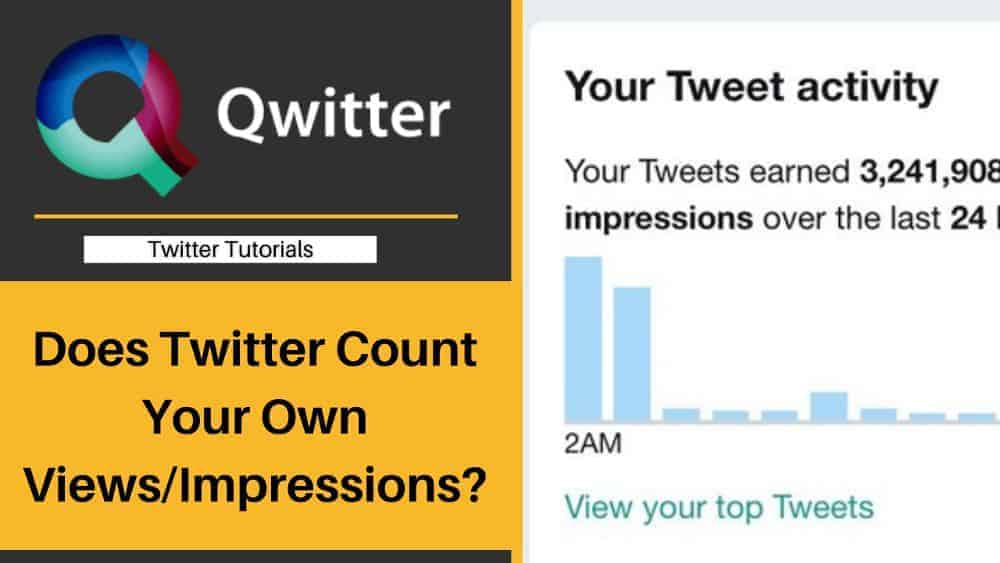Twitter users need to track the performance of their tweets to enhance their marketing measures. Sometimes, users do not have complete knowledge of specific metrics. One such is impressions. Twitter users are confused and wonder Does Twitter Count their Own Views/Impressions?
This article will help you resolve this doubt. You can explore why some of your tweets get more impressions and tricks to increase them.

Does Twitter Analytics include your own profile visits?
No, Twitter analytics doesn’t include a user’s own profile visits. The Tweet activity page helps users explore their tweet’s performance. You can also track how individuals engage with your posts in real-time.
You can click on any specific Tweet to get a clear picture & detailed insights on total retweets, follow, likes, replies, or clicks received.
Does Twitter count own video views?
No, Twitter doesn’t count a user’s own video views. Twitter has created an analytics dashboard inside the Media Studio to help users analyze the performance of their published videos.
You can view the following video metrics within the media Studio through interactions made by the audience.
- Total Views
- Organic Views
- Promoted Views
- Completion Rate
- Average Watch Time
- Country of viewership
- Platform of viewership
How Does Twitter Count Views
Twitter counts views on tweets by impressions. For videos, Twitter uses the video view metric. It triggers when anyone watches any video for at least 2 seconds or views at least 50% of the video. Twitter counts impression when-
- tweets appear in the home feeds of followers
- Search results when specific keywords and hashtags are added.
Are Twitter profile views accurate?
There’s no clear picture of how accurate profile views are. This metric is recollected for 28 days and updated daily. Profile views only show in number.
You can’t come to know about your views and specifically who visited your Twitter profile. They can be anyone from random people to your friends, family members, or colleagues.
How Twitter Defines Impressions
Twitter defines impressions as the total times a tweet appears in a user’s search results or timeline. An impression doesn’t clearly indicate whether a person viewed a tweet or not. Suppose a person opens his timeline, and the tweet is served.
Now, if due, for any reason, the user scrolls his feed without actually reading or clicking on the tweet, even it will count in the impression.
Impressions don’t give any information about the user. Twitter doesn’t include a user’s own impressions of his posts. Anyone cannot manipulate their impression rate by viewing their tweet many times.
Do Impressions Matter?
Yeah, up to an extent, impressions matter. Impressions points toward how many users viewed a tweet. Impressions are suitable as a benchmarking strategy. Users can find out that people are viewing their content.
Suppose your tweets receive an average of 150 impressions every time you post. If your tweets receive more impressions, you will comprehend they went someplace.
So, you can follow down precisely WHY it acquired this much attention. Impressions help to count the click-through rate over a post.
How Did My Tweet Get So Many Impressions?
There can be some possible reasons.
The tweet was created over a trending topic.
If anyone tweets about a trendy topic, the probability is more people are reading and writing about that. They can come across your tweet while browsing their search results and related hashtags. You will receive relatively more impressions because trending topics gain significant traffic. That’s what makes them trends.
Your tweet got featured or mentioned someplace different from Twitter.
If you have added your tweets links in different blog posts, if anyone clicks on them, it gives a new impression. If you have added embed tweets with the page loading, the tweet loads giving a new impression.
Your tweet received engagements from someone with many followers.
Here, influencer marketing plays a significant role in getting more impressions, retweets, comments, shares, etc. If any popular influencer retweets or comments on your tweet, the better impressions it will deliver when shared.
How Many Impressions is Good on Twitter
No number signifies impressions as “adequate or poor.” In the case of Tweet Impressions, if a user receives 20% more impressions than their followers, it’s good. More % will be excellent. It conveys that 20% of your followers or potential audience have seen your tweet.
How to Get More Impressions on Your Tweets
Here are some tweets to get more impressions on your tweets.
Tweet more frequently.
This technique functions to give people more tweets to view and engage with. The more you tweet, the more chances of your posts going viral. Automatically tweets will start getting more impressions and unique followers. Test different kinds of content, including emojis, hashtags, tag people, various topics, etc.
Tweet at times when the audience/followers are most functional.
Suppose you posted a tweet at 2 pm. Most of your followers sign in to their account after 5 pm. Your post will go down in their timeline. They will view the recently posted tweets first. Posting during most active hours brings you better visibility naturally.
We recommend a tool called Tweriod to research your specific followers to see at what times they become active on Twitter.
Make heavy usage of hashtags.
Research the relevant hashtags with your content. You can include 1-3 hashtags in your tweet. Learn how to find and use trending hashtags in your post. Observe the competitor’s posts from your niche to explore more hashtags for your use.
Encourage engagements, especially retweets.
Asking for a retweet can help in boosting impressions and engagements.
Don’t ask for a retweet on irrelevant posts. People retweet the posts they find informative or helpful for others—for example, user posts about an orphan dog and request people to come forward for adoption. There are more chances people will retweet it to help the dog.
Analyze and search content people find interesting and worth retweeting.
The essence of influencer marketing lies in manipulating people to give more retweets.